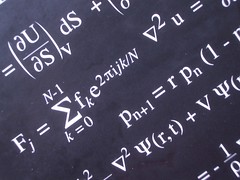 |
The paper `Remarks on Contact and Jacobi Geometry‘ with Katarzyna Grabowska and Janusz Grabowski now been published in SIGMA [1]. |
In the paper we present a rather general formalism to define and study Jacobi and Kirllov structures using principle \(\mathbb{R}^\times\)-bundles equipped with homogeneous Poisson structures. This approach was first described by Grabowski [2]. This set-up allows for a rather economical description of contact/Jacobi groupoids and related structures. Importantly, by using homogeneous Poisson structures we simplify the overall picture of contact/Jacobi/Kirillov geometry and show that many technical proofs of various statements in the theory are drastically simplified. We think that this approach gives new insight into the existing theory and hopefully the ideas will be useful to others.
Contact Geometry
Contact geometry is motivated by the formalism of classical mechanics, and in particular looking at constant energy surfaces in phase space. Jacobi geometry is the `degenerate brother’ of contact geometry, and Kirillov geometry is the `twisted sister’ of Jacobi geometry – for those that know think of the relation between symplectic and Poisson geometry, and then trivial and non-trivial line bundles. Contact geometry clearly from its conception has broad applications in physics, ranging from classical mechanics, geometric optics and thermodynamics. There are also some mathematical applications such as knot invariants and invariants in low dimensional topology.
Lie groupoids
Another facet of this paper are Lie groupoids, which should be through of as a wider setting to discuss symmetries than groups. Very loosely, a groupoid is a `many object’ group, and a Lie groupoid is a `geometric’ version of a groupoid. Associated with any Lie group is a Lie algebra, which describes infinitesimal (so `very small’) symmetries of geometric entities. Likewise, associated with any Lie groupoid is a Lie algebroid. Without any details, a Lie algebroid should be considered as describing `very small’ symmetries associated with a Lie groupoid. However, unlike Lie groups and algebras, not every Lie algebroid comes from a Lie groupoid!
Why study contact/Jacobi/Kirillov Groupoids?
Bringing contact and groupoids together is, in the standard setting, not so easy. Our formalism makes this much clearer and allows for direct generalisations to Jacobi geometry. But why bring them together in the first place?
Alan Weinstein [3] introduced the notion of a symplectic groupoid with the intention of extending methods from geometric quantisation to Poisson manifolds. Very loosely, the geometry of Lie groupoids is needed in geometric approaches that allow a passage from classical mechanics to quantum mechanics. In a sense, one can think of symplectic and Poisson groupoids as the Lie groupoid versions of the phase spaces found in classical mechanics, i.e., the spaces formed by position and momentum.
Since the initial work of Weinstein the topic of symplectic and Poisson groupoids has exploded, largely motivated by the geometry of classical mechanics – not that all practitioners see this!
Similarly, given the role of contact geometry in physics, it is natural to think about groupoid versions of contact and Jacobi geometry. More than this, it turns out that the integrating objects of Jacobi/Kirillov structures are precisely contact groupoids (as we define them). That is, as soon as one thinks about the `degenerate brother’ and `twisted sister’ of contact geometry one encounters contact groupoids as the `finite versions’.
For me, all this is strongly motivated by the basic questions of the geometry of classical mechanics. It is rather amazing that we are pushed rather quickly into more and more difficult ideas in geometry. And this is before we get into the quantum world!
Acknowledgments
I personally thank the anonymous referees for their effort in reading the paper and providing many helpful comments and suggestions. For sure the paper would not be what it is today without them.
References
[1] Andrew James Bruce, Katarzyna Grabowska and Janusz Grabowski, Remarks on Contact and Jacobi Geometry, SIGMA 13 (2017), 059, 22 pages.
[2] Janusz Grabowski, Graded contact manifolds and contact Courant algebroids, J. Geom. Phys. 68 (2013), 27-58.
[3] Alan Weinstein, Symplectic groupoids and Poisson manifolds, Bull. Amer. Math. Soc. (N.S.) 16 (1987), 101-104.